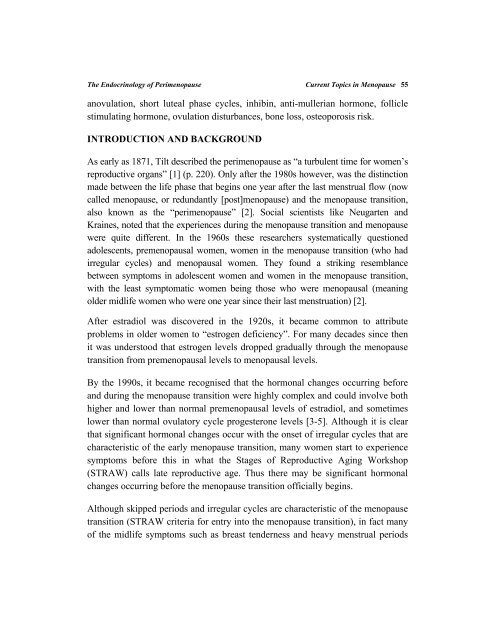Download - Bentham Science
Download - Bentham Science
Download - Bentham Science
Create successful ePaper yourself
Turn your PDF publications into a flip-book with our unique Google optimized e-Paper software.
The Endocrinology of Perimenopause Current Topics in Menopause 55<br />
anovulation, short luteal phase cycles, inhibin, anti-mullerian hormone, follicle<br />
stimulating hormone, ovulation disturbances, bone loss, osteoporosis risk.<br />
INTRODUCTION AND BACKGROUND<br />
As early as 1871, Tilt described the perimenopause as “a turbulent time for women’s<br />
reproductive organs” [1] (p. 220). Only after the 1980s however, was the distinction<br />
made between the life phase that begins one year after the last menstrual flow (now<br />
called menopause, or redundantly [post]menopause) and the menopause transition,<br />
also known as the “perimenopause” [2]. Social scientists like Neugarten and<br />
Kraines, noted that the experiences during the menopause transition and menopause<br />
were quite different. In the 1960s these researchers systematically questioned<br />
adolescents, premenopausal women, women in the menopause transition (who had<br />
irregular cycles) and menopausal women. They found a striking resemblance<br />
between symptoms in adolescent women and women in the menopause transition,<br />
with the least symptomatic women being those who were menopausal (meaning<br />
older midlife women who were one year since their last menstruation) [2].<br />
After estradiol was discovered in the 1920s, it became common to attribute<br />
problems in older women to “estrogen deficiency”. For many decades since then<br />
it was understood that estrogen levels dropped gradually through the menopause<br />
transition from premenopausal levels to menopausal levels.<br />
By the 1990s, it became recognised that the hormonal changes occurring before<br />
and during the menopause transition were highly complex and could involve both<br />
higher and lower than normal premenopausal levels of estradiol, and sometimes<br />
lower than normal ovulatory cycle progesterone levels [3-5]. Although it is clear<br />
that significant hormonal changes occur with the onset of irregular cycles that are<br />
characteristic of the early menopause transition, many women start to experience<br />
symptoms before this in what the Stages of Reproductive Aging Workshop<br />
(STRAW) calls late reproductive age. Thus there may be significant hormonal<br />
changes occurring before the menopause transition officially begins.<br />
Although skipped periods and irregular cycles are characteristic of the menopause<br />
transition (STRAW criteria for entry into the menopause transition), in fact many<br />
of the midlife symptoms such as breast tenderness and heavy menstrual periods
















